
Calisthenics uses bodyweight exercises to build strength, flexibility, and coordination․ It includes movements like push-ups, squats, and dips, with PDF guides available for structured workouts․
What is Calisthenics?
Calisthenics is a form of exercise that uses bodyweight as resistance to build strength, endurance, flexibility, and coordination․ It involves functional movements like pushing, pulling, squatting, and lunging, often requiring no equipment․ Originating in ancient Greece, calisthenics has evolved to include modern variations of classic exercises such as push-ups, squats, and dips․ It is accessible to all fitness levels, making it a versatile and effective way to improve overall physical fitness․ By focusing on body control and movement, calisthenics promotes holistic development without the need for specialized gear․
Benefits of Calisthenics Training
Calisthenics training offers numerous benefits, including increased strength, improved flexibility, and enhanced coordination․ It promotes muscle endurance and cardiovascular fitness without requiring specialized equipment․ By focusing on bodyweight exercises, calisthenics allows for functional movement patterns that improve daily mobility and athletic performance․ It also enhances mental discipline and body awareness․ The portability of calisthenics workouts makes them ideal for any setting, and their scalability caters to all fitness levels, from beginners to advanced trainees․ This holistic approach fosters overall physical and mental well-being, making it a popular choice for sustainable fitness․
Why Use a PDF Guide for Calisthenics Exercises?
A PDF guide for calisthenics exercises provides a structured, portable, and accessible resource for planning and tracking workouts․ It offers detailed exercise lists, step-by-step instructions, and progressive routines tailored to different fitness levels․ PDF guides are easily downloadable and can be used offline, making them ideal for any training environment․ They often include visual aids and customizable plans, ensuring a comprehensive approach to achieving fitness goals․ This convenience and completeness make PDF guides an essential tool for anyone serious about calisthenics training․
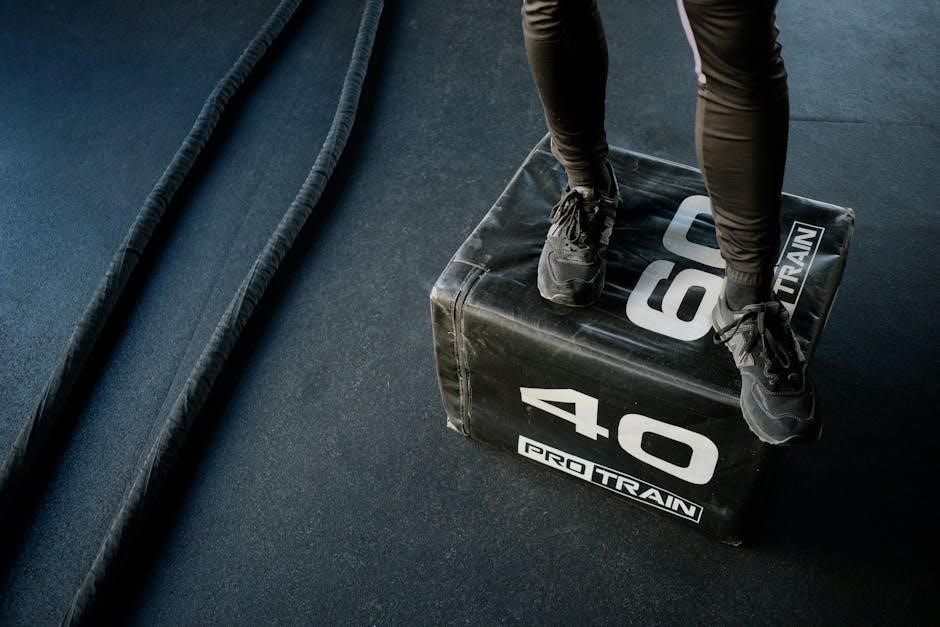
Full Body Calisthenics Workout Program
A full-body calisthenics routine engages all major muscle groups using bodyweight exercises like push-ups, squats, and dips․ It enhances strength, flexibility, and endurance efficiently, with PDF guides available․
Structure of a Full Body Routine
A full-body calisthenics routine typically starts with a dynamic warm-up to prepare muscles․ It includes upper body exercises like push-ups and dips, lower body moves such as squats and lunges, and core-strengthening exercises like planks and hollow bodies․ The workout is divided into sets and reps, allowing for progressive overload․ A structured routine ensures all muscle groups are engaged, promoting balanced development․ Many PDF guides provide detailed workout schedules, exercise lists, and tips for scaling movements based on fitness levels, ensuring an efficient and effective training experience for everyone․
Key Exercises for Full Body Workouts
Key exercises for full-body calisthenics workouts include push-ups, pull-ups, bar dips, squats, and lunges․ These movements target multiple muscle groups simultaneously, ensuring efficient training․ Push-ups focus on the chest, shoulders, and triceps, while pull-ups and dips work the upper body․ Squats and lunges engage the legs and core․ Planks and hollow body holds are essential for core stability․ These exercises are foundational and can be scaled to suit different fitness levels․ Many PDF guides provide detailed lists of these exercises, along with variations to help individuals progress effectively in their training journey․
Sample Workout Schedule
A sample calisthenics workout schedule might include three full-body sessions per week․ Day 1 could focus on push-ups, squats, and lunges (3 sets of 10-15 reps each)․ Day 2 might involve pull-ups, dips, and planks (3 sets of 8-12 reps)․ Day 3 could include advanced movements like pseudo planche push-ups and dragon flags (3 sets of 6-10 reps)․ Rest periods of 1-2 minutes between sets and 3-4 minutes between exercises are recommended․ Warm-up routines and cool-down stretches should be incorporated to ensure safety and recovery․ Consistency and progressive overload are key to success․ Many PDF guides provide detailed schedules like this, making it easy to follow structured routines․
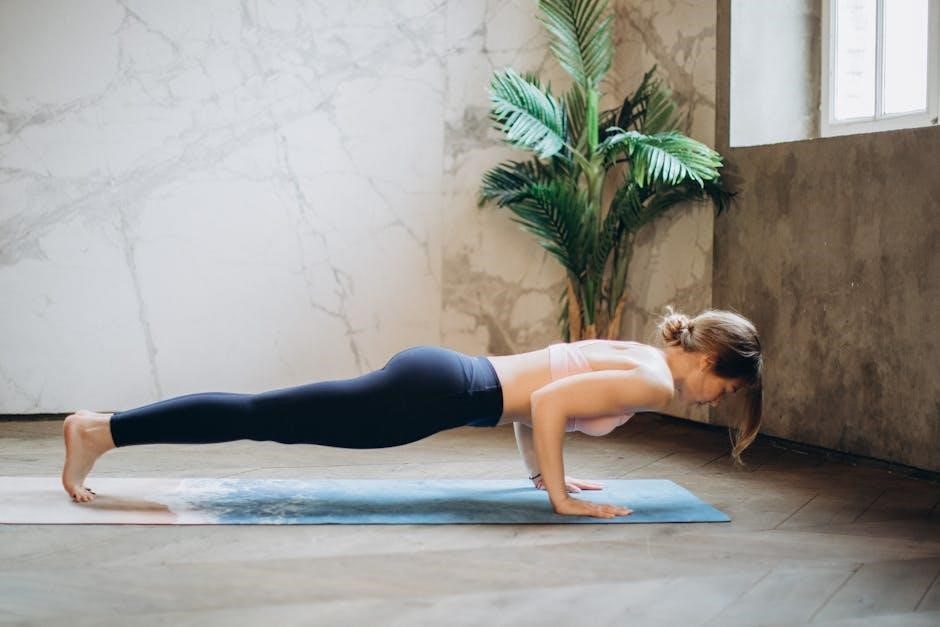
Calisthenics Exercises by Muscle Group
Calisthenics exercises target specific muscle groups, such as upper body (push-ups, dips), lower body (squats, lunges), and core (planks, dragon flags), enhancing overall strength and flexibility․
Upper Body Exercises
Upper body calisthenics exercises focus on building strength and endurance in the chest, shoulders, and arms․ Push-ups are a foundational exercise, targeting the chest and triceps․ Bar dips work the triceps and shoulders, while pseudo planche push-ups challenge the chest and shoulders․ Inverted rows are excellent for building back and arm strength․ Chin-ups and pull-ups target the latissimus dorsi and biceps․ These exercises can be modified or progressed to suit different fitness levels, making them accessible to both beginners and advanced practitioners․ Regular practice helps improve posture and overall upper body aesthetics;
Lower Body Exercises
Lower body calisthenics exercises target the legs and hips, enhancing strength, agility, and overall lower body functionality․ Squats are a cornerstone, working the quadriceps and glutes․ Pistol squats challenge single-leg strength and balance․ Lunges improve coordination and target the hamstrings and quads․ Glute bridges and hip thrusts focus on the glutes, while calf raises strengthen the lower legs․ These exercises can be performed anywhere without equipment, making them ideal for home workouts․ They are essential for building a strong foundation and improving athletic performance in various activities․
Core and Stability Exercises
Core and stability exercises in calisthenics focus on strengthening the abdominals, obliques, and lower back muscles․ Planks are a fundamental exercise, engaging the entire core and improving posture․ Hollow body holds build stability and control, while dragon flags target the lower abs and hip flexors․ Russian twists and leg raises also enhance rotational strength and core endurance․ These exercises improve balance, stability, and overall athletic performance․ Incorporating them into your routine helps maintain proper form during other movements and reduces injury risk․ They are versatile and can be modified to suit different fitness levels, making them essential for a well-rounded workout․
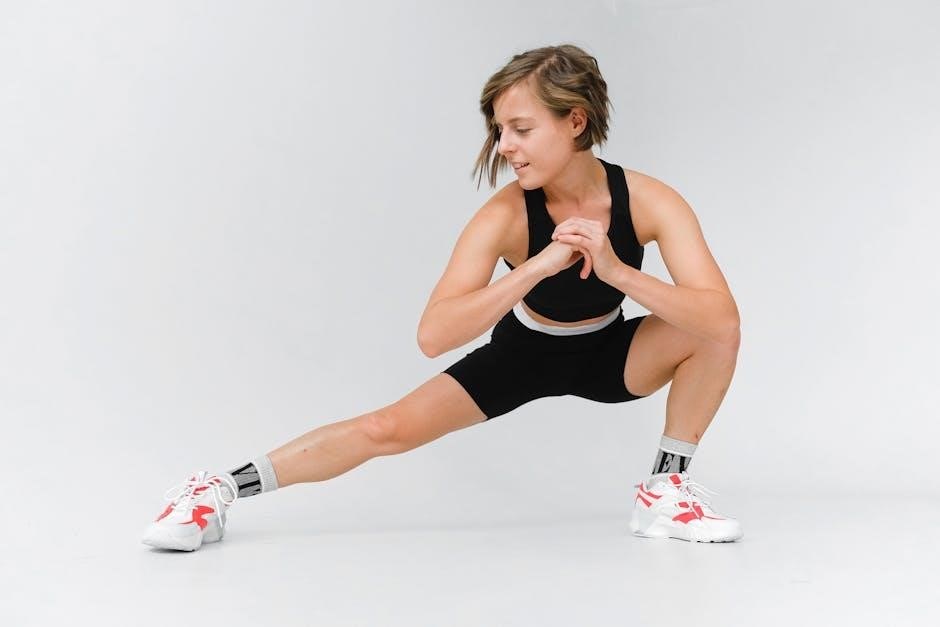
Advanced Calisthenics Exercises
Advanced calisthenics includes complex movements like pseudo planche, dragon flag, and planche push-ups․ These exercises require mastery of basic techniques and build exceptional strength and control․
- Pseudo Planche: Develops shoulder and core strength․
- Dragon Flag: Targets lower abs and hip flexors․
- Planche Push-Ups: Builds advanced upper body strength․
These exercises challenge even experienced practitioners and showcase elite-level calisthenics skills․
Pseudo Planche
The pseudo planche is an advanced calisthenics exercise that mimics the planche position but with a modified setup․ It targets the shoulders, chest, and core muscles, improving strength and control․
- Performed with hands elevated on surfaces like parallettes or bars․
- Requires proper form to avoid injury and maximize effectiveness․
- Progresses toward the full planche by building foundational strength․
This exercise is a key step for those aiming to master the planche, offering a challenging yet achievable variation for intermediate to advanced practitioners․ Regular practice enhances stability and overall upper body power․
Dragon Flag
The Dragon Flag is an advanced core exercise popularized by strongmen and strength athletes․ It involves lying on your back and lifting your legs while maintaining a straight line from head to heels․ This movement targets the lower back, abs, and hip flexors, building exceptional core strength․ To perform it safely, start with modified variations and progress gradually․ It’s a challenging exercise that requires control and power, making it a standout in calisthenics routines for those seeking to enhance their core stability and overall strength․ Regular practice improves posture and athletic performance․
Planche Push-Ups
Planche push-ups are an advanced calisthenic exercise requiring immense upper body strength and control․ Performed in a planche position, with hands supporting the body in a straight line, this exercise targets the chest, shoulders, and triceps․ It’s a progression from standard push-ups, demanding full-body engagement and balance․ To master it, build up with planche holds and partial reps․ Including planche push-ups in your routine enhances muscular endurance, coordination, and overall upper body development․ Consistency and proper form are key to safely achieving this impressive exercise and advancing your calisthenics journey․

Calisthenics Workout Plan for Beginners
A 3x full body workout routine trains all muscle groups three times weekly․ Ideal for building foundational strength, it includes push-ups, squats, and core exercises, progressing gradually․
Day 1: Upper Body Focus
Start with a dynamic warm-up to prepare your muscles․ Focus on push-ups (3 sets of 8-12 reps), inverted rows (3 sets of 8-12 reps), and bar dips (3 sets of 8-15 reps)․ Rest for 1-2 minutes between sets․ Engage your core with hollow body holds (3 sets of 30-60 seconds) to improve stability․ Cool down with stretching to prevent soreness․ Adjust exercises based on your fitness level, using modifications like knee push-ups or assisted dips if needed․ Consistency and proper form are key to building strength progressively․
Day 2: Lower Body Focus
Begin with a dynamic warm-up to activate your lower body․ Focus on squats (3 sets of 12-15 reps), lunges (3 sets of 10-12 reps per leg), and glute bridges (3 sets of 15-20 reps)․ Rest for 1-2 minutes between sets․ Incorporate calf raises (3 sets of 20-25 reps) for ankle strength․ For advanced individuals, try pistol squats or single-leg deadlifts․ For intermediates, use bodyweight step-ups or assisted lunges․ Maintain proper form to avoid injury and maximize results․ Cool down with stretching to enhance flexibility and recovery․
Day 3: Core and Mobility
Start with a 5-10 minute dynamic warm-up to prepare your core and improve mobility․ Focus on hollow body holds (3 sets of 30-60 seconds), dragon flags (3 sets of 8-12 reps), and leg raises (3 sets of 12-15 reps)․ Incorporate side plank variations (3 sets of 20-30 seconds per side) for oblique engagement․ Add cat-cow stretches (3 sets of 10-12 reps), seated forward bends (3 sets of 20-30 seconds), and child’s pose (3 sets of 30-60 seconds) for mobility․ Rest for 1-2 minutes between sets․ Prioritize proper form to prevent injury and enhance flexibility․ Cool down with deep breathing exercises to aid recovery․
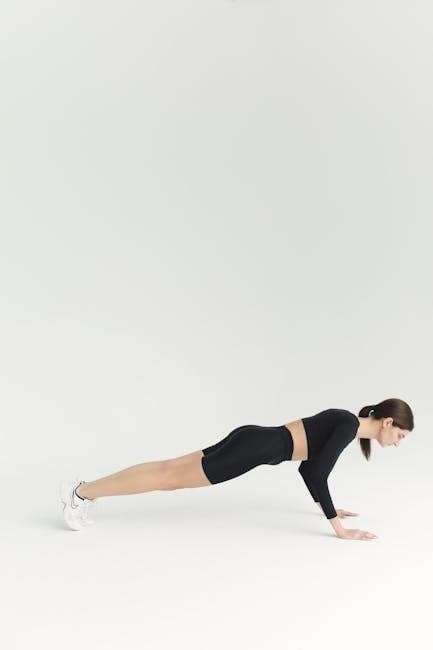
Training Methods
Straight sets are effective for building strength․ Adequate rest periods ensure proper recovery․ Progressive overload helps gradually increase intensity over time for continuous improvement and muscle growth․
Straight Sets
Straight sets involve performing a set number of repetitions for each exercise without alternating between different exercises․ For example, completing three sets of 8-12 push-ups with 1-2 minutes of rest in between allows for focused muscle engagement and strength building․ This method is efficient for targeting specific muscle groups and improving endurance․ It is commonly used in full-body workouts to maximize time and effort, ensuring consistent progress in calisthenics training․ Many PDF guides include straight sets as a core component of their structured routines․
Rest Periods
Rest periods are crucial for recovery and performance in calisthenics training․ Typically, 1-2 minutes of rest is recommended between sets of the same exercise, while 2-3 minutes is suggested between different exercises․ This allows muscles to recover and rebuild, enhancing strength and endurance․ For more intense workouts, longer rest periods of 3-4 minutes may be necessary․ Properly timed rest ensures optimal progress and reduces the risk of overtraining․ Many PDF guides detail specific rest intervals to help structure workouts effectively and maximize results․
Progressive Overload
Progressive overload is a key principle in calisthenics, involving gradual increases in exercise intensity․ This can be achieved by adding reps, reducing rest time, or advancing to more challenging variations․ For example, moving from standard push-ups to one-arm or decline push-ups․ Many PDF guides outline progression strategies, ensuring continuous improvement․ Incorporating progressive overload helps build strength and muscle effectively, keeping workouts engaging and preventing plateaus․ It’s essential to track progress and adjust routines accordingly for sustained fitness gains and overall development․
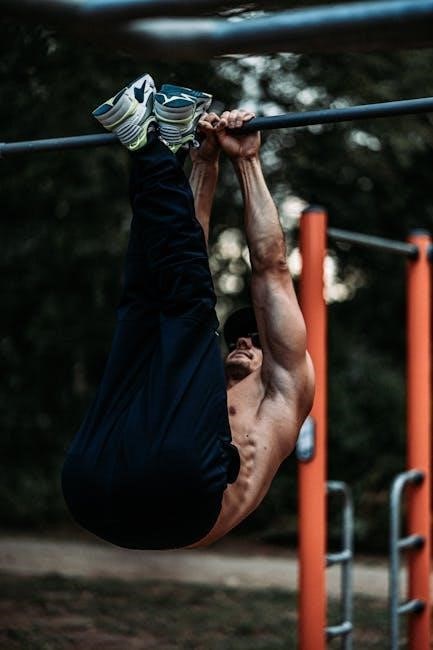
Exercise Progression and Scaling
Calisthenics exercises can be scaled to suit all fitness levels․ Techniques include modifying movement angles, increasing reps, or advancing to more complex versions like one-arm push-ups․ PDF guides often provide detailed scaling options to ensure continuous progress and challenge, making workouts adaptable for both beginners and advanced practitioners․ This flexibility allows individuals to tailor their training effectively, promoting consistent improvement and engagement․
Beginner Variations
For those starting with calisthenics, beginner variations simplify exercises to build foundational strength․ Push-ups can be modified to knee push-ups, reducing difficulty while maintaining the core movement․ Squats can transition to bodyweight squats, focusing on proper form without added resistance․ PDF guides often list these variations, ensuring newcomers can progress safely․ These modifications allow individuals to master basic movements before advancing, fostering confidence and preventing injuries․ By starting with manageable exercises, beginners establish a strong base for more challenging routines in the future․
Intermediate Modifications
Intermediate modifications enhance the difficulty of basic exercises while maintaining proper form․ For example, pistol squats add balance and depth to standard squats, targeting the legs and core․ Inverted rows can be elevated to increase intensity, while pike push-ups introduce an incline for shoulder-focused training․ PDF guides often detail these variations, offering clear progressions․ These modifications challenge intermediate trainees to build strength and coordination without overcomplicating movements․ By incorporating these adjustments, individuals can gradually increase difficulty, preparing for advanced exercises while refining their technique and avoiding injury․
Advanced Progressions
Advanced progressions in calisthenics involve complex movements that require mastery of strength, control, and technique․ Exercises like the pseudo planche, dragon flag, and planche push-ups represent the pinnacle of bodyweight training․ These movements challenge the upper body, core, and stability, often requiring precise balance and coordination․ PDF guides detail these advanced exercises, offering step-by-step instructions to safely progress from intermediate to elite levels․ Mastery of these skills showcases dedication and advanced physical conditioning, pushing the limits of what is possible with bodyweight training alone․

Calisthenics PDF Resources
Calisthenics PDF guides offer structured workout plans, detailed exercise lists, and variations for all fitness levels․ They provide printable routines, ensuring accessible and organized training programs․
Benefits of Using a PDF Guide
A calisthenics PDF guide provides a structured and organized approach to training, offering detailed exercise lists, workout plans, and progress tracking․ It eliminates the need for guesswork, ensuring consistency and focus․ PDFs are easily accessible, printable, and portable, making them ideal for workouts anywhere․ They often include visual demonstrations, tips, and modifications for different fitness levels․ Additionally, PDF guides are cost-effective and customizable, allowing users to tailor routines to their goals․ Many trustworthy sources offer high-quality, downloadable PDFs, making it simple to start or enhance a calisthenics journey․
How to Download Calisthenics Exercise Lists
To download calisthenics exercise lists, visit reputable fitness websites or platforms offering free PDF guides․ Search for terms like “calisthenics workout list PDF” or “calisthenics exercise list download․” Many sites provide printable PDFs with detailed exercise instructions and routines․ Some sources, like Summerfunfitness or Google Sheets, offer comprehensive lists for various fitness levels․ Once found, click the download link, save the PDF, and print it for easy reference․ Ensure the source is trustworthy to access high-quality, safe, and effective workout plans tailored to your needs․
Trustworthy Sources for Calisthenics PDFs
Reputable websites like Summerfunfitness, Google Sheets, and fitness forums offer reliable calisthenics PDFs․ Platforms such as Reddit communities and specialized fitness sites provide well-structured guides․ Ensure sources are verified to avoid low-quality content․ Look for PDFs from experienced trainers or established fitness organizations․ Always check reviews or user feedback to confirm the credibility of the source before downloading․ This ensures access to safe, effective, and well-designed workout plans tailored to various fitness levels and goals․
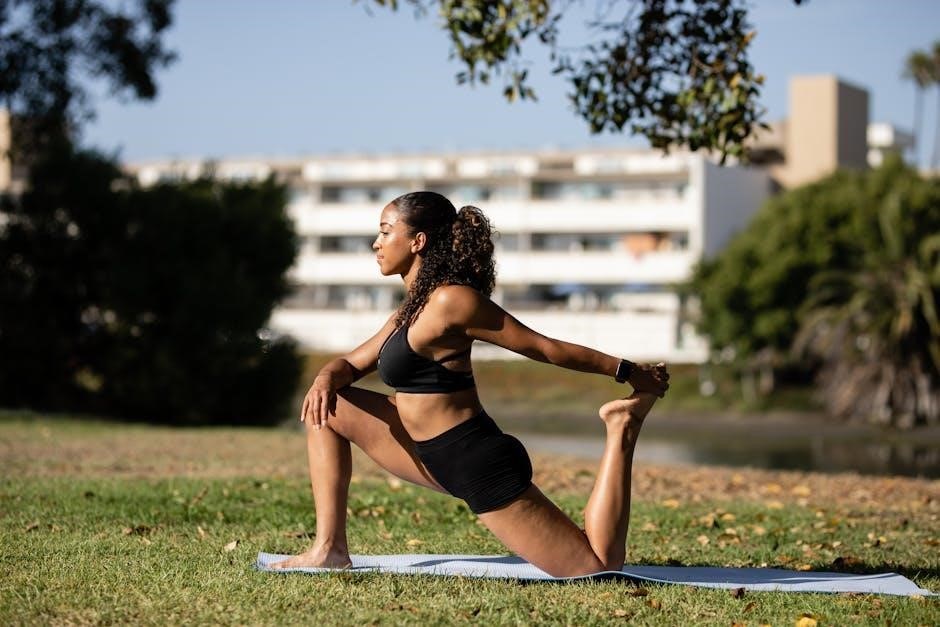
Equipment Needed for Calisthenics
Basic equipment includes a pull-up bar, parallel bars, and a sturdy surface․ Optional gear like resistance bands or a mat can enhance your training experience․
Basic Equipment
The essential equipment for calisthenics includes a sturdy pull-up bar for exercises like pull-ups and chin-ups․ Parallel bars are necessary for dips and other upper body movements․ A flat, non-slip surface or mat is recommended for comfort during floor exercises like push-ups and planks․ While these are the basics, some routines may require additional gear, but many exercises can be performed with minimal or no equipment, making calisthenics accessible almost anywhere․
Optional Equipment
Optional equipment for calisthenics includes resistance bands, which can add intensity to exercises like pull-aparts or chest presses․ A weighted vest is another option to increase the difficulty of movements like squats or lunges․ Wrist straps or gloves can provide additional grip support during exercises like pull-ups or bar dips․ A timer or stopwatch is useful for tracking workout intervals or rest periods․ These tools can enhance your training but are not essential for basic calisthenics routines․
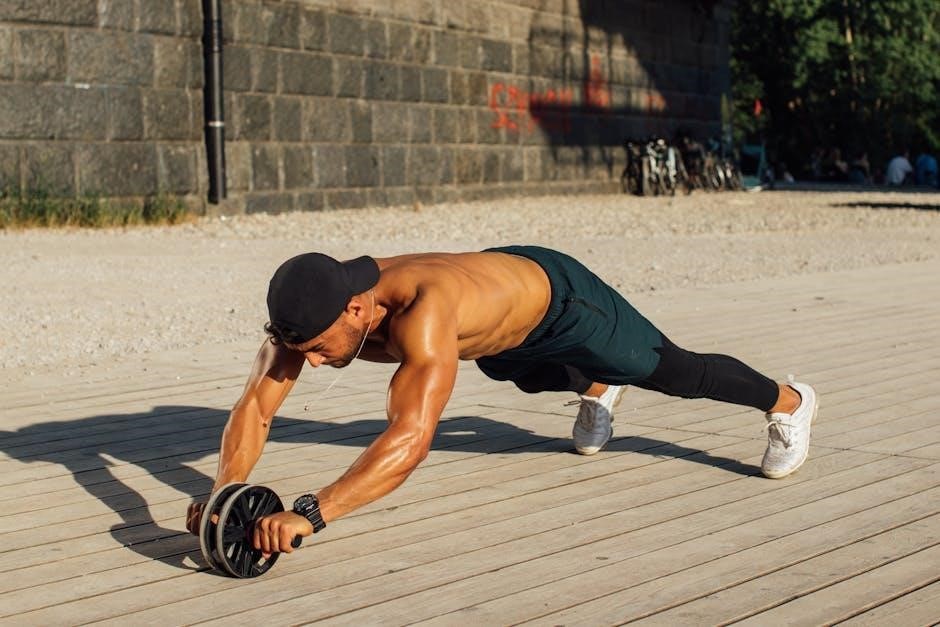
Safety and Form in Calisthenics
Proper form is crucial to prevent injuries․ Common issues include overstretching and poor alignment․ Always warm up and cool down to ensure safety and effectiveness․
Importance of Proper Form
Importance of Proper Form
Proper form is essential for maximizing the effectiveness of calisthenics exercises while minimizing injury risk․ It ensures that muscles are targeted correctly, preventing strain and enhancing overall fitness․ Maintaining good form helps build strength efficiently and avoids poor movement patterns․ Additionally, proper form promotes balance and stability, making workouts safer and more productive․ Even slight adjustments can significantly impact results, making it crucial to focus on technique from the start․ Prioritizing form ensures sustainable progress and long-term success in calisthenics training․
Common Injuries to Avoid
Common injuries in calisthenics include shoulder strains, lower back issues, and knee pain, often due to overtraining or poor form․ Wrist injuries can occur from improper hand positioning during exercises like push-ups or handstands․ Pull-up related injuries, such as grip strains, are also prevalent․ Overreliance on momentum rather than controlled movements can lead to muscle imbalances and joint stress․ To prevent these, focus on proper form, gradual progression, and adequate warm-ups․ Addressing weaknesses and avoiding excessive volume can help mitigate risks and ensure safe, effective training․
Warm-Up and Cool-Down Routines
A proper warm-up enhances flexibility and prepares muscles for exercise, reducing injury risk․ Start with light cardio like jogging or jumping jacks, followed by dynamic stretches such as arm circles, leg swings, and cat-cow stretches․ Incorporate muscle activations like glute bridges and planks to engage core stability․ For cool-down, static stretches like hamstring and chest stretches help improve flexibility and promote recovery․ Gentle movements and deep breathing can also aid in lowering heart rate and relaxing muscles post-workout, ensuring a balanced routine for optimal performance and health․
Calisthenics offers a versatile path to fitness, building strength and flexibility without equipment․ Stay consistent, embrace progressive overload, and enjoy the journey to a healthier, stronger you․
Final Tips for Success
Consistency is key—train regularly and track progress․ Start with basic exercises and gradually incorporate advanced moves․ Focus on proper form to prevent injuries․ Stay motivated by setting achievable goals and celebrating milestones․ Incorporate progressive overload to build strength and muscle․ Listen to your body and rest when needed․ Combine calisthenics with a balanced diet for optimal results․ Stay hydrated and ensure adequate sleep for recovery․ Explore various routines and find what works best for you․ Most importantly, stay disciplined and patient—success in calisthenics is a journey, not a destination․
Encouragement to Start Training
Starting your calisthenics journey can seem daunting, but remember, every great athlete began with their first exercise․ Calisthenics is accessible to everyone, regardless of fitness level․ You don’t need expensive equipment or a gym membership—just your body and determination․ Begin with basic movements like push-ups, squats, and planks, and gradually progress․ Celebrate small victories and stay consistent․ The sense of achievement and strength you’ll gain is incredibly rewarding․ Embrace the process, stay motivated, and watch your body transform over time․ You’ve got this—start today and take control of your fitness journey!